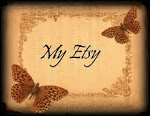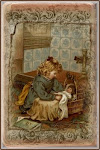Many styles of the sunbonnets were made, fancy versions for church and social occasions, sturdy homespun bonnets for doing farm chores and warm wool bonnets for the harsh and cold winters on the prairie.Straw bonnets were popular because straw was so readably available. Girls and ladies found braiding bonnets to be an enjoyable pastime.
Many of the garments that girls and ladies wore were made to be practical and wear well. Aprons and pinafores were a must when working or doing chores in the kitchen. Dresses were simple styles with long full skirts and long sleeves that could be rolled up for working or fancier sleeve styles were made for Sunday Dresses.The styles for fancy dresses or Sunday Dresses were kept relatively simple in design, perhaps accented with hand made lace or some pretty pieces of silk on the neckline or sleeves. For winter time, girls and ladies wore warm wool coats and knitted or crocheted scarves, shawls and hats or bonnets. A Petticoat was a must have item in any girls or ladies wardrobe. Made of a pretty white cotton or linen a lady always tried her best to keep them snowy white even on the dusty prairie. Petticoats were also a place that girls could practice their lace making skills and embroidery work. Girls and ladies would often have a couple petticoats, one for everyday, another for Sunday best and finally a heavy flannel or wool on for winter. If you wanted to look especially stylish you could layer on more then one petticoat for a full skirted effect
Pioneer girls and ladies would wear jewelry to dress up many of their outfits. Pins, Cameos and brooches of all kinds were popular to wear on blouses, dresses and shawls. Earrings or earbobs, as they were called in the 1800’s, necklaces, lockets and bracelets were still worn just as they are today. Ladies were also fond of wearing pin watches; these were delicate little watch faces attached to a pin and were put on upside down so that the wearer could reach down and look at the face of the watch and it would be the right side to her. Pioneer Ladies learned to make their own fabrics with homespun fibers and colored the cloth with home made dyes. Vegetables & flowers were the most popular items used for dying colors. Ever wonder how the old fabrics got their color back then? No rit dye in those times! Interested in trying your hand at a little Pioneer Fabric Dyeing?
a great source for natural dyes can be found right in your own back yard! Roots, nuts and flowers are just a few common natural ways to get many colors. Yellow, orange, blue, red, green, brown and grey are available.
Gathering plant material for dyeing: Blossoms should be in full bloom, berries ripe and nuts mature. Remember, never gather more than 2/3 of a stand of anything in the wild when gathering plant stuff for dying.
To make the dye solution:
Chop plant material into small pieces and place in a pot. Double the amount of water to plant material. Bring to a boil, then simmer for about an hour. Strain. Now you can add your fabric to be dyed. For a stronger shade, allow material to soak in the dye overnight.
Getting the fabric ready for the dye bath:
You will have to soak the fabric in a color fixative before the dye process. This will make the color set in the fabric.
Color Fixatives:
Salt Fixative (for berry dyes) 1/2 cup salt to 8 cups cold water
Plant Fixatives (for plant dyes) 4 parts cold water to 1 part vinegar
Add fabric to the fixative and simmer for an hour. Rinse the material and squeeze out excess. Rinse in cool water until water runs clear.
Dye Bath:
Place wet fabric in dye bath. Simmer together until desired color is obtained. The color of the fabric will be lighter when its dry. Also note that all dyed fabric should be laundered in cold water and separately.
Muslin, silk, cotton and wool work best for natural dyes and the lighter the fabric in color, the better. White or pastel colors work the best.
NOTE: It's best to use an old large pot as your dye vessel. Wear rubber gloves to handle the fabric that has been dyed, the dye can stain your hands. It's also important to note, some plant dyes may be toxic, check with the Poison Control Center if unsure. Here is a list of a few plants to use..
Shades of orange:
Onion skin
Turmeric dyed cloth will turn orange or red if it is dipped in lye.
Barberry (mahonia sp.) yellow orange (with alum) very strong & permanent. Any part of the plant will work.
Shades of brown:
Tea Bags (light brown)
Acorns (boiled)
Coffee Grinds
Oak bark will give a tan or oak color.
Shades of pink:
Strawberries
Cherries
Raspberries
Shades of red:
Beets (deep red)
Dandelion (root)
Red leaves will give a reddish brown color I use salt to set the dye.
Shades of blues & lavender:
Blueberries
Mulberries (royal purple)
Grapes (purple)
Japanese indigo (deep blue)
Shades of black-grey:
Iris (roots)
Sumac (leaves) (Black)
Shades of green:
Spinach (leaves)
Black-Eyed Susans
Red onion (skin) (a medium green, lighter than forest green)
Artichokes
Shades of yellow:
Onion (skins)
Marigold (blossoms)
Celery (leaves)
Paprika ( shade of pale yellow - light orange)
Dandelion flower










.jpg)






































































.jpg)


























.JPG)















4 comments:
This is the best kind of history. I LOVE to learn about how they dressed, what they wore and why, how they made it, etc. This was a GREAT post. Thanks!
Patricia :o)
Hey Sue...check out my blog...there's something there for you. Congratulations!
This is so interesting to me. I would love to visit back in time, not sure if I could live that way though. It would be interesting to see if I could though.
This is so interesting to me. I would love to be able to go back in time and see what it was like. Not sure if I could live that way but I'd give it a try for sure. I always said I was born in the wrong era, lol.
Post a Comment